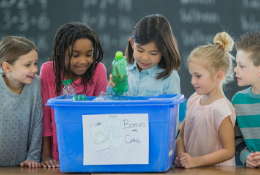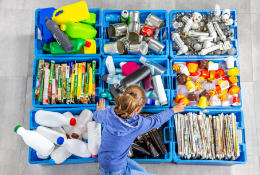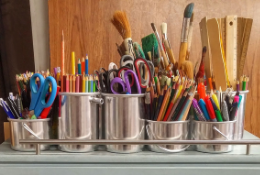School Waste Reduction Programs
Schools and universities generate about 562,442 tons of waste each year in California. Almost half of the school waste is comprised of organic materials like paper, cardboard, and uneaten cafeteria food. Much of the waste generated in the California education system is recyclable.
Many school districts have been successful in improving their economic and environmental performance through the implementation of waste reduction initiatives.
Laws That Affect Schools
Laws Affecting Schools and Local Education Agencies
Mandatory Commercial Recycling (AB 341)
The Mandatory Commercial Recycling (MCR) law went into effect in June 2012 and requires public entities that generate a certain threshold of solid waste per week to reuse, recycle, compost, or otherwise divert solid waste from disposal.
Mandatory Commercial Organics Recycling (AB 1826)
Mandatory Organic Recycling (MORe) requires regulated entities to implement an organic waste recycling program to divert food waste, green waste, landscape and pruning waste, nonhazardous wood waste, and food-soiled paper waste that is mixed in with food waste.
AB 827
AB 827 supports AB 341 and AB 1826 covered generators by making recycling and organic recycling containers available to customers. Wherever recycling or organic waste is generated, a school must provide an appropriate container adjacent to the solid waste container to capture and divert recycling and organic waste. Containers must be easily accessible, visible, and clearly labeled. CalRecycle has customizable labels available for download.
Short-Lived Climate Pollutants: Organic Waste Methane Emissions Reduction (SB 1383)
Schools and local education are required to prevent, reduce the generation of, and recycle organic waste. If they have an on-site food facility, they are required to recover edible food.
Other Related School Recycling & Sustainability Laws
Public Resources Code, sections 42620-42622 requires CalRecycle to provide assistance to school districts in implementing source reduction and recycling programs, including:
- A survey of school districts on their level of program implementation
- Development of a model waste reduction program
- Training and ongoing technical and informational assistance
- Information on programs for other states and institutions
California Education Code, sections 32370-32376, encourages each school district to establish and maintain a paper recycling program in all classrooms, administrative offices, and other areas owned or leased by the school district. These sections also encourage school districts to:
- Purchase recycled paper
- Purchase the paper with the highest percentage of post-consumer waste
- Revise procurement specifications to give preference to the purchase of recycled paper
For questions or to request assistance in setting up a districtwide waste reduction program, contact your CalRecycle regional local assistance representative.
Administration and Personnel
Strategies for Each Department within a School District
District Administration: Suggestions on how to provide administrative direction and support through districtwide integrated waste management policy and administrative procedures.
Facilities and Planning: Excellent resources regarding greening school district building projects, including the recycling of construction and demolition wastes. (Note: This information is part of CalRecycle’s Sustainable Green “Building” site.)
Child Nutrition/School Cafeteria: Waste reduction ideas for the cafeteria and kitchen, including “Offer Versus Serve,” food donations, recycling, composting, school gardens, and more.
Purchasing: Tips on how to purchase for waste reduction and how to buy recycled and other environmentally preferable products.
Technology Services: CalRecycle’s Electronic Product Management site provides information and resources regarding reuse, recycling, and proper disposal of old computer equipment or other electronic devices.
Waste Prevention Ideas
Waste Prevention Ideas
Reduce Paper Waste Whenever Possible
- Allow students to submit homework on the back side of used paper.
- Duplicate handouts using both sides of the paper.
- Approach school administrators about purchasing a copy machine that makes duplex copies if your current copier doesn’t.
- Avoid printing extra handouts.
- Keep a box for various types of scratch papers (single-sided, construction, etc.).
- Bind scrap paper to use for taking notes.
- Maximize the use of an overhead projector and black /whiteboard to minimize the use of dittoed information.
- Place worksheets in plastic sleeves. Have students write with crayons and erase with carpet squares.
Product Purchasing
- Purchase products that are easy to repair.
- Purchase durable goods.
- Purchase refillable products (e.g., pens and pencils).
- Purchase products made with recycled materials.
- Purchase or make reusable displays. Borrow or trade displays with other teachers.
- Bring lunch in reusable containers, e.g., use a thermos and cloth lunch bag or lunch box. Encourage students to do the same!
- Use reusable dishware for class parties. Consider having each student keep his/her own cup, plate, and utensils for parties.
- Set up a table at the end of semesters for students to place unwanted pencils, notebooks, etc.
Making Lapboards
You can make lap boards from masonite boards, roughly 12″ x 18″. Paint these with two coats of chalkboard paint, ‘cured’ by rubbing chalk across the board, and washed with a wet cloth. The rule of thumb for chalkboard paint is one pint per classroom.
Students can use old socks or carpet squares for erasers. The amount of paper saved could justify purchasing the materials. (Students could estimate the amount of paper saved over a specified period of time.)
Waste Prevention in Administrative Offices and Teacher’s Lounges
- Post memos and general bulletins next to teacher’s mailboxes instead of making individual copies.
- Set up boxes to collect paper used on one side only. Reuse blank sides of paper in laser printers or as scratch pads.
- Use centralized files for hard copies instead of individual file systems.
- Reuse manila envelopes/file folders.
- Circulate magazines rather than buying multiple subscriptions.
- Use a half sheet of paper for short messages and memos.
- When sending notes to parents, send one per family rather than one with each student.
- Reuse packaging and packing materials.
- Buy sugar, coffee, and tea in bulk. Use reusable coffee filters (metal or cloth) or ones made from unbleached paper.
- Drink from reusable mugs. Set up storage rack for mugs.
- Bring lunch in reusable containers.
- Keep reusable dishware on hand to use for lunch or parties.
Waste Prevention at Special Events
- Avoid giving away junk prizes that break easily or will be thrown away.
- Design decorations that can be reused.
- Don’t release balloons into the environment. The balloons can cause problems for wildlife.
- Select a menu that eliminates the need for service ware.
- For example, serve sandwiches, fruit, cookies, and other finger foods.
- Use reusable tablecloths, plates, cups, and utensils if practical.
- Have everyone label their cups so they can keep track of them.
- Ask attendees to share programs or handouts.
- If name tags are needed, select ones that can be reused. Collect the tags at the end of the event and use them again.
- Set out clearly labeled reuse or recycling bins at an event.
- Use both sides of poster board before recycling or discarding.
- Inform the public about the “greenness” of the event and how they can contribute (e.g., bring your own plate).
Other Waste Prevention Ideas
- Provide staff training on waste prevention. Educating staff on cost savings/benefits will empower them to identify alternatives.
- Award or recognize waste prevention efforts.
- Set up monthly “No-Waste Days” where the object is to create as little waste as possible.
- Create PTA positions for waste prevention and recycling.
- Sponsor the sale of reusable lunch bags or lunch boxes to cut down on disposable lunch bags.
- Check to see if your area has a materials exchange for art supplies, furniture, books, or other materials.
- Set up swaps to exchange goods.
- Set up a waste display to educate students and faculty.
Grants and Funding
Grants and Funding Opportunities
- Community Composting for Green Spaces Grant
- CalRecycle’s competitive grant program is provided to increase the number of community groups operating small-scale composting programs in green spaces within disadvantaged and low-income communities.
- Food Waste Prevention and Rescue Grant
- CalRecycle’s competitive grant program assists in lowering overall greenhouse gas emissions by establishing new or expanding existing food waste prevention projects in California by reducing the amount of food being disposed in landfills.
- Reuse Grant Program
- Investment in reuse is needed for waste reduction projects.
- Tire-Derived Product Grant
- Tire-derived products are used for a variety of applications, including as a playground surface and mulch (chips, bark), and storm water mitigation measures.
- Clean School Bus Replacement Program
- The California Air Resources Board offers several financial incentives to increase the number of clean school buses in operation and to drive the development of cleaner technologies by speeding up their adoption by school fleet owners.
- Farm to School Grants
- The U.S. Department of Agriculture’s annual competitive grant program supports planning, developing, and implementing farm-to-school programs and activities.
- Waste Reduction Grants
- StopWaste offers a range of grant opportunities on an annual basis to both non-profits and businesses, aimed at increasing individual, business, and community involvement in the reduction of waste in Alameda County.
Award and Recognition Programs
Award and Recognition Programs
- Green Ribbon Schools Award Program
- California K-12 Schools Recycling Challenge
- US EPA’s Food Recovery Challenge
- California School Boards Association Golden Bell Awards
- Presidential Innovation Award for Environmental Educators
- President’s Environmental Youth Award
- Go Green Initiative
- Eco-Schools USA
- Ten Strands
- The California Center for Civic Participation (Cal Center)
- BCK Programs, LLC: Environmental Education



School Cafeterias
The U.S. EPA food recovery hierarchy helps schools prioritize how to handle food waste.

School Waste Composition
Learn more about the types of materials a school generates and how to reduce waste and recycle more.

School Administration
Resources to help school administrators draft and implement environmental policies in their school districts.

Environmentally Preferable Purchasing for Schools
Information for school purchasing agents and officers to facilitate the implementation of environmentally preferable purchasing (EPP) practices.
For more information contact: Schools Program, Schools@calrecycle.ca.gov.
